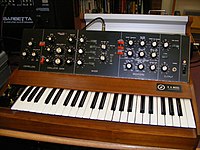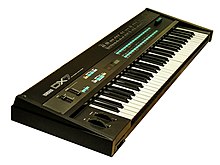Synthesizer

Đàn synthesizer (thường gọi tắt là "synthesizer" hay "synth", còn có thể viết là "synthesiser") hay đàn tổng hợp âm thanh[1] là một nhạc cụ điện tử tạo ra tín hiệu điện, sau đó được chuyển đổi thành âm thanh thông qua amplifier và loa hoặc tai nghe.[2] Synthsizer có thể giả lập lại những tiếng đã có sẵn (các loại nhạc cụ, giọng hát, âm thanh trong tự nhiên, v.v.) hoặc tạo ra những âm sắc mới chưa từng tồn tại trước đây. Đàn thường được chơi với đàn keyboard, nhưng có thể được điều khiển thông qua nhiều thiết bị đầu vào, bao gồm music sequencer, instrument controller, fingerboard, guitar synthesizer, wind controller và trống điện tử. Synthesizer không có điều khiển được tích hợp sẵn thường được gọi là sound module và được điều khiển thông qua cổng MIDI hoặc CV/Gate sử dụng một thiết bị điều khiển khác.[3]
Các loại đàn synthesizer sử dụng các cách khác nhau để tạo ra tín hiệu. Trong số đó phổ biến nhất là subtractive synthesis, additive synthesis, wavetable synthesis, frequency modulation synthesis, phase distortion synthesis, physical modeling synthesis và sample-based synthesis. Các loại ít phổ biến hơn gồm subharmonic synthesis, granular synthesis. Trong thập niên 2010, đàn synthesizer được sử dụng nhiều trong các thể loại như pop, rock và nhạc dance.[4][5][6]





Xem thêm
[sửa | sửa mã nguồn]- Synthesizer khác nhau
- Guitar synthesizer
- Keyboard bass
- Keyta
- Modular synthesizer
- Semi-modular synthesizer
- String synthesizer
- Bộ điều khiển gió
- Các công cụ & công nghệ liên quan
- Linh kiện & công nghệ
- Thể loại nhạc
Tham khảo
[sửa | sửa mã nguồn]- ^ Shaw, G D (tháng 2 năm 1973). “Sound Synthesiser”. Practical Electronics. 9 (2): 140. Truy cập ngày 10 tháng 1 năm 2020.
- ^ Reid, Gordon (2000). “Synth Secrets, Part 9: An Introduction to VCAs”. Sound on Sound (January 2000). Truy cập ngày 25 tháng 5 năm 2010.
- ^ Vail 2000, tr. 68
- ^ “Palatin project”. Bản gốc lưu trữ ngày 15 tháng 4 năm 2014. Truy cập ngày 11 tháng 2 năm 2016.
- ^ Borthwick 2004, tr. 120
- ^ Borthwick 2004, tr. 130
Thư mục
[sửa | sửa mã nguồn]- Borthwick, Stuart (2004), Popular Music Genres: An Introduction, Edinburgh University Press, tr. 120, ISBN 0-7486-1745-0
- Holmes, Thom (2008), Electronic and experimental music: technology, music, and culture (ấn bản thứ 3), Taylor & Francis, ISBN 978-0-415-95781-6, truy cập ngày 4 tháng 6 năm 2011
- Vail, Mark (2000), Vintage Synthesizers: Groundbreaking Instruments and Pioneering Designers of Electronic Music Synthesizers, Backbeat Books, tr. 68–342, ISBN 0-87930-603-3[liên kết hỏng]
Đọc thêm
[sửa | sửa mã nguồn]- Crombie, David (1986). New Complete Synthesizer. Omnibus Press. ISBN 0711907013.
- Gorges, Peter (2005). Programming Synthesizers. Germany, Bremen: Wizoobooks. ISBN 978-3-934903-48-7.
- Schmitz, Reinhard (2005). Analog Synthesis. Germany, Bremen: Wizoobooks. ISBN 978-3-934903-01-2.
- Shapiro, Peter (2000). Modulations: A History of Electronic Music: Throbbing Words on Sound. Caipirinha Productions, USA. ISBN 1-891024-06-X.
- Kuit, Roland (2014). SoundLab I: The Electronic Studio. Publisher's number: 13664. The Netherlands, The Hague: Donemus.
- Kuit, Roland (2014). SoundLab II: Architectures for Philosophers. Publisher's number: 13665. The Netherlands, The Hague: Donemus.
- Kuit, Roland (2014). Laboratory of Patching: Illustrated Compendium of Modular Synthesis. Publisher's number: 13662. The Netherlands, The Hague: Donemus.
- Kuit, Roland (2014). To be On, to be OFF, that's the SWITCH. Publisher's number: 13666. The Netherlands, The Hague: Donemus.
Liên kết ngoài
[sửa | sửa mã nguồn]- Sound Synthesis Theory wikibook
- Principles of Sound Synthesis Lưu trữ 2016-01-20 tại Wayback Machine tại Đại học Salford
- Synthesizer Tutorial Lưu trữ 2022-06-11 tại Wayback Machine
